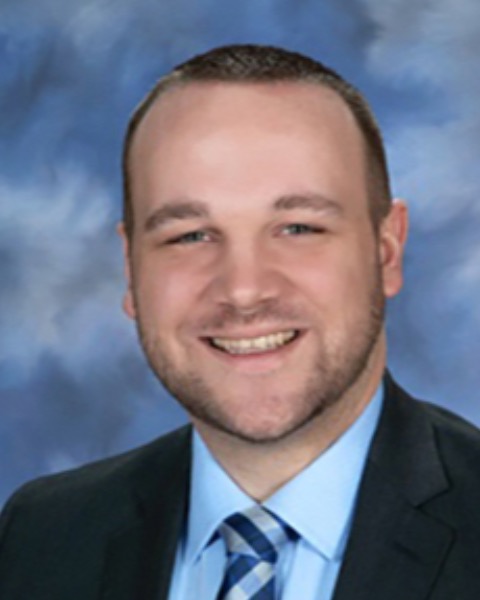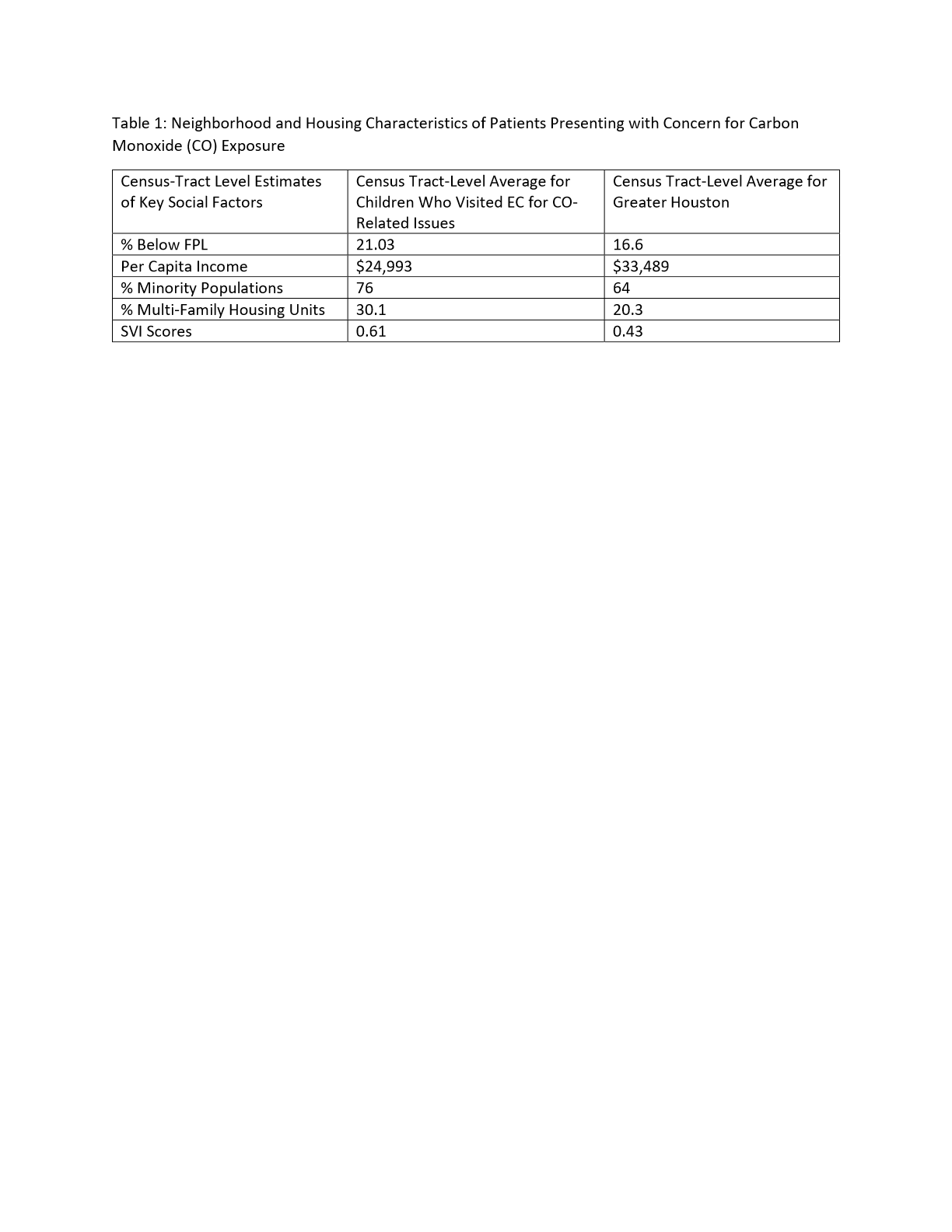Emergency Medicine: All Areas
Category: Abstract Submission
Emergency Medicine XI
395 - Communities Affected by Carbon Monoxide Exposure After Winter Storm Uri
Sunday, April 24, 2022
3:30 PM - 6:00 PM US MT
Poster Number: 395
Publication Number: 395.315
Publication Number: 395.315
Elyse Portillo, Texas Children's Hospital/Baylor College of Medicine, Houston, TX, United States; Eric A. Russell, Baylor College of Medicine & Texas Children's Hospital, Houston, TX, United States; Zachary C. Foughty, Baylor College of Medicine, Houston, TX, United States; Kathryn Fisher, Baylor College of Medicine, Houston, TX, United States; Asha T. Morrow, Baylor College of Medicine, Houston, TX, United States; Casandra Quinones, Baylor College of Medicine, Houston, TX, United States; Shubhada Hooli, Baylor College of Medicine/Texas Children's Hospital, Houston, TX, United States; Stephen A. Harding, Baylor College of Medicine, Houston, TX, United States; Ryan Ramphul, UTHealth, Houston, TX, United States; Elizabeth A. Camp, Baylor College of Medicine, Houston, TX, United States

Zachary C. Foughty, MD, MBA, MPA
Clinical Fellow
Baylor College of Medicine
Houston, Texas, United States
Presenting Author(s)
Background: In February 2021, Winter Storm Uri brought record cold temperatures to the US Gulf Coast. A Texas power grid failure left millions without electricity for up to a week. As Houstonians turned to unconventional heat sources, area emergency centers saw record numbers of carbon monoxide (CO) exposure cases.
Objective: This case series aims to describe individual- and neighborhood-level social characteristics of patients evaluated for CO exposure at one of three pediatric emergency department (PED) sites in a quaternary care children’s hospital system in Houston, TX, and to determine if the burden of CO exposure fell disproportionately on certain communities.
Design/Methods: We queried the electronic medical record (EMR) database of all PED arrivals from February 13-17, 2021, for CO-related discharge diagnoses and CO lab orders, and defined cases as those with concern of CO exposure and/or presenting symptoms ultimately attributed to CO exposure after chart review. Clinical and demographic data were abstracted from the EMR. We securely geocoded case home addresses using ArcGIS ProÒ and Street Map Premium Address LocatorÒ, then pulled Census 2018 and country appraisal district data to describe neighborhood and housing characteristics.
Results: A total of 78 patients (59 children) from 34 individual households had CO exposure. Of these, 58% had a non-English language preference, 49% had public insurance, and 37% were self-pay or uninsured. Cases came from neighborhoods with lower per capita income, higher percentages of residents living at or below the 2018 federal poverty level, higher percentages of racial and ethnic minority residents, higher percentages of multi-family housing units, and higher social vulnerability index (SVI) scores than those of Greater Houston (Table 1). More than half of the case homes were multi-family units, and most of the homes were built more than 35 years ago. Figure 1 shows case households on the 2018 census tract SVI score map of Greater Houston.Conclusion(s): Patients who visited the PED for CO exposure during the Winter Storm Uri related electricity outage tended to be uninsured or publicly insured and prefer a non-English language. Cases generally came from poorer neighborhoods with a higher percentage of racial and ethnic minority residents, multi-family housing units, and SVI score. These findings are in line with studies that suggest that natural disasters disproportionately affect racial and ethnic minority communities and socially vulnerable populations. Targeted interventions may improve disaster readiness in these neighborhoods.
Case Households Mapped on 2018 Census Tract SVI Score Map of Greater Houston.png) The CDC SVI (Social Vulnerability Index) Score uses U.S. census data to determine the social vulnerability of every census tract in the US, and scores each tract from 0-1, based on 15 social factors (such as poverty, lack of vehicle access, crowded housing, etc.). Lower scores (close to 0) indicate low social vulnerability, while higher scores (close to 1) indicate high social vulnerability.
The CDC SVI (Social Vulnerability Index) Score uses U.S. census data to determine the social vulnerability of every census tract in the US, and scores each tract from 0-1, based on 15 social factors (such as poverty, lack of vehicle access, crowded housing, etc.). Lower scores (close to 0) indicate low social vulnerability, while higher scores (close to 1) indicate high social vulnerability.
Table 1: Neighborhood and Housing Characteristics of Patients Presenting with Concern for Carbon Monoxide (CO) Exposure
Objective: This case series aims to describe individual- and neighborhood-level social characteristics of patients evaluated for CO exposure at one of three pediatric emergency department (PED) sites in a quaternary care children’s hospital system in Houston, TX, and to determine if the burden of CO exposure fell disproportionately on certain communities.
Design/Methods: We queried the electronic medical record (EMR) database of all PED arrivals from February 13-17, 2021, for CO-related discharge diagnoses and CO lab orders, and defined cases as those with concern of CO exposure and/or presenting symptoms ultimately attributed to CO exposure after chart review. Clinical and demographic data were abstracted from the EMR. We securely geocoded case home addresses using ArcGIS ProÒ and Street Map Premium Address LocatorÒ, then pulled Census 2018 and country appraisal district data to describe neighborhood and housing characteristics.
Results: A total of 78 patients (59 children) from 34 individual households had CO exposure. Of these, 58% had a non-English language preference, 49% had public insurance, and 37% were self-pay or uninsured. Cases came from neighborhoods with lower per capita income, higher percentages of residents living at or below the 2018 federal poverty level, higher percentages of racial and ethnic minority residents, higher percentages of multi-family housing units, and higher social vulnerability index (SVI) scores than those of Greater Houston (Table 1). More than half of the case homes were multi-family units, and most of the homes were built more than 35 years ago. Figure 1 shows case households on the 2018 census tract SVI score map of Greater Houston.Conclusion(s): Patients who visited the PED for CO exposure during the Winter Storm Uri related electricity outage tended to be uninsured or publicly insured and prefer a non-English language. Cases generally came from poorer neighborhoods with a higher percentage of racial and ethnic minority residents, multi-family housing units, and SVI score. These findings are in line with studies that suggest that natural disasters disproportionately affect racial and ethnic minority communities and socially vulnerable populations. Targeted interventions may improve disaster readiness in these neighborhoods.
Case Households Mapped on 2018 Census Tract SVI Score Map of Greater Houston
.png) The CDC SVI (Social Vulnerability Index) Score uses U.S. census data to determine the social vulnerability of every census tract in the US, and scores each tract from 0-1, based on 15 social factors (such as poverty, lack of vehicle access, crowded housing, etc.). Lower scores (close to 0) indicate low social vulnerability, while higher scores (close to 1) indicate high social vulnerability.
The CDC SVI (Social Vulnerability Index) Score uses U.S. census data to determine the social vulnerability of every census tract in the US, and scores each tract from 0-1, based on 15 social factors (such as poverty, lack of vehicle access, crowded housing, etc.). Lower scores (close to 0) indicate low social vulnerability, while higher scores (close to 1) indicate high social vulnerability.Table 1: Neighborhood and Housing Characteristics of Patients Presenting with Concern for Carbon Monoxide (CO) Exposure

